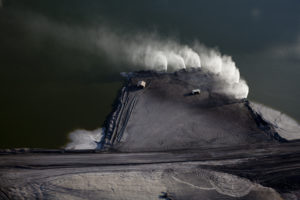by Derf Johnson
Montana is riddled with the ghosts of industries past – the Berkeley Pit, the Clark Fork River, the Zortman/Landusky, Beal Mountain, and Belt Creek mines, the ASARCO smelter site in East Helena, the asbestos contamination in Libby – just to name a few. The list goes on and on, for both recent as well as historic sites, at which the land and water have been polluted and degraded, and, too often, which have required taxpayer funds to remediate and manage them.

Toxic coal sludge at the Colstrip ash ponds. Photo (c) Kestrel Aerial Services, Inc.
Unfortunately, the Colstrip coal-fired power plant and its associated facilities are likely to be added to this list of industrial projects that have turned out to be environmental disasters. However, after years of dogged legal work, mainly by Earthjustice and MEIC, and continuous pressure applied to both the Montana Department of Environmental Quality (DEQ) and the corporate owners of Colstrip, a major source of water pollution at Colstrip will ultimately be addressed and controlled.
Each year, during the process of burning coal to produce electricity, the Colstrip plant produces over one million tons of “coal ash.” Coal ash contains carcinogens and neurotoxins including arsenic, boron, cadmium, lead, selenium, and other contaminants. At Colstrip, where what is known as the “wet” storage method is used, the coal ash is stored in three separate impoundment systems amounting to over 800 acres of toxic lakes. Since their construction, the corporate owners of Colstrip have known that these ponds were leaking badly and contaminating the local ground and surface water. In fact, they were so certain that the leakage would occur that they actually budgeted during the pond development and planning process for having to purchase a new water system for the City of Colstrip in anticipation of ruining the underlying groundwater.

Toxic coal sludge ponds at Colstrip. Photo (c) Kestrel Aerial Services, Inc.
Annually, approximately 200 million gallons of coal ash sludge, an amount that would almost fill an entire Olympic swimming pool each day, leaks from the network of cool swimsuits. Because this environmental disaster was being almost entirely ignored, if not accepted, by DEQ, a coalition of organizations including MEIC, the Sierra Club, and the National Wildlife Federation, represented by Earthjustice, filed a lawsuit in 2012 against DEQ for its failure to enforce Montana law and the terms of Colstrip’s operating permit. After years of legal work, in July 2016 the groups entered into a settlement agreement with the owners of Colstrip.
Under the agreement, Colstrip’s largest units (#3 & #4), which generate the majority of coal ash for the plant, must convert to the “dry” disposal method, which is far safer and less likely to pollute groundwater. Specifically, before 2019 a portion of the coal ash called “bottom ash” must be dewatered before it is disposed of, and by July 1, 2022, all of the coal ash waste from the unit’s scrubbers must be disposed of as a dry waste. This settlement did not address Colstrip’s smaller units (#1 & #2), as a separate settlement agreement will bring about the closure of those units by July 1, 2022.
Once the owners of Colstrip convert units 3 & 4 to dry disposal, they can focus on trying to clean up the groundwater that has already been polluted, without continuing to add to it. Montana has Jenny Harbine, an incredibly adept attorney with Earthjustice, who led the legal work on the coal ash ponds, to thank for this incredible victory.

